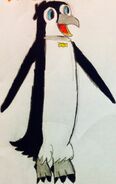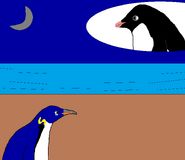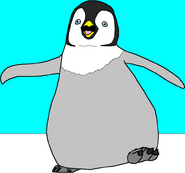Make sure that you are adding information worth mentioning!
If you want others know that this character, location, item, and any other appears in someone's fan-fiction, please, at least use a few sentence to describe it in the Appearances in Fanfictions section!
For the species pages, they will only have to use the section Fanon (Species Name) on this Wiki. Like this on the right:

Adults and a juvenile on Snow Hill Island, Antarctica
Emperor Penguin is one of 18 penguin species in Antarctica. They are also the species who has the larger species. In the Happy Feet series, The Emperor Penguins are the main penguin species in Antarctica.
Description[]
Emperors are the largest of all penguins—an average bird stands some 45 inches (115 centimeters) tall. These flightless animals live on the Antarctic ice and in the frigid surrounding waters.
Penguins employ physiological adaptations and cooperative behaviors in order to deal with an incredibly harsh environment, where wind chills can reach -76°F (-60°C).
They huddle together to escape wind and conserve warmth. Individuals take turns moving to the group's protected and relatively toasty interior. Once a penguin has warmed a bit it will move to the perimeter of the group so that others can enjoy protection from the icy elements.
Emperor penguins spend the long winter on the open ice—and even breed during this harsh season. Females lay a single egg and then promptly leave it behind. They undertake an extended hunting trip that lasts some two months! Depending on the extent of the ice pack, females may need to travel some 50 miles (80 kilometers) just to reach the open ocean, where they will feed on fish, squid, and krill. At sea, emperor penguins can dive to 1,850 feet (565 meters)—deeper than any other bird—and stay under for more than 20 minutes.
Male emperors keep the newly laid eggs warm, but they do not sit on them, as many other birds do. Males stand and protect their eggs from the elements by balancing them on their feet and covering them with feathered skin known as a brood pouch. During this two-month bout of babysitting the males eat nothing and are at the mercy of the Antarctic elements.
When female penguins return to the breeding site, they bring a belly full of food that they regurgitate for the newly hatched chicks. Meanwhile, their duty done, male emperors take to the sea in search of food for themselves.
Mothers care for their young chicks and protect them with the warmth of their own brood pouches. Outside of this warm cocoon, a chick could die in just a few minutes. In December, Antarctic summer, the pack ice begins to break up and open water appears near the breeding site, just as young emperor penguins are ready to swim and fish on their own. The mothers also have dangerously strong maternal instincts, as they have been known to kidnap other chicks to replace their own that have been lost.
Fanon Emperor Penguins on this Wiki[]
Here are a few of the fanon emperor penguins on this wiki:
- Ashley
- Terry the Penguin
- Mary
- Joshua
- Katie
- John
- Edwin the Emperor Penguin
- Dorcena
- Lauren
- Tarry the Penguin
- Terri the Penguin
- Vivien the Emperor Penguin
- Nate
- Danielle the Emperor Penguin
- Phoenix
... and view more here.
Now for a list of stories about emperor penguins, click here.
Trivia[]
- Mumble as a baby emperor penguin can swim in Happy Feet: The Videogame, but this is unrealistic, because emperor penguin chicks first enter the water to swim when they are about six and a half months old, and are unable to swim when covered in down.
- In order to tell the difference between the male and female emperor penguins, look at their beaks. If it has an orange spot, it's a male. If the spot is pink, it's a female. Also, the golden crest on the "breast" areas anthropomorphically correspond to gender differences.
Gallery[]
<gallery>
Happy-feet-happy-feet-604428 714 474.jpg|The Emperor-Land penguins graduates and dive into the sea for the first time in Happy Feet













